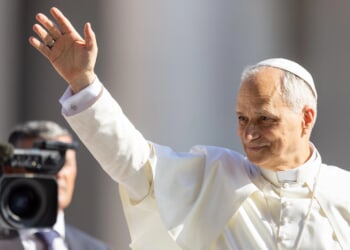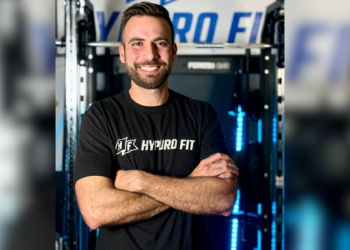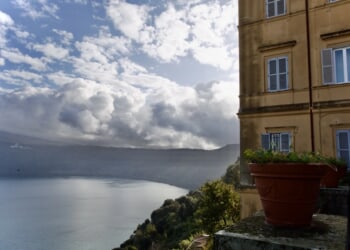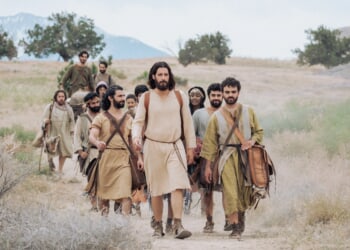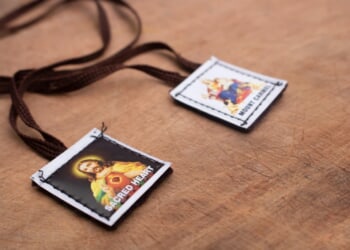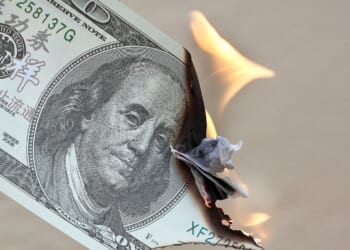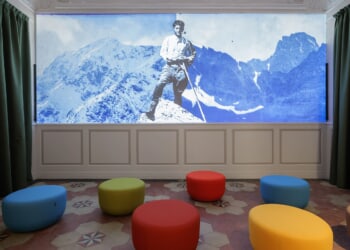Washington, D.C. Newsroom, Jun 12, 2025 /
06:00 am
While locals are joining in on parts of the 2025 National Eucharisitc Pilgrimage as it winds its way across the country, eight young Catholics have dedicated the last three weeks to traveling the entire route with the Eucharist as “Perpetual Pilgrims” — and accompanying them are seven chaplains who take turns to serve as their spiritual guides.
Maria Benes, director of pilgrims for the National Eucharistic Congress, told CNA that there are five priests and two religious brothers who have been rotating through the pilgrimage. Three started with the pilgrims and four are expected to end the trek in Los Angeles on June 22.
The priest chaplains are Capuchin Franciscan Fathers Christopher Iwancio and Michael Herlihey, and Franciscan Friars of the Renewal Fathers Malachy Joseph Napier, Justin Jesúsmarie Alarcón, and Lawrence Joshua Johnson. The religious brothers are Brothers Jan Cyril Vanek and Damiano Mary Pio, both of the Franciscan Friars of the Renewal.
“As a lot of them have told me, the nature of pilgrimage is very Franciscan with the flexibility and adaptability of the adventure with Jesus,” Benes said.
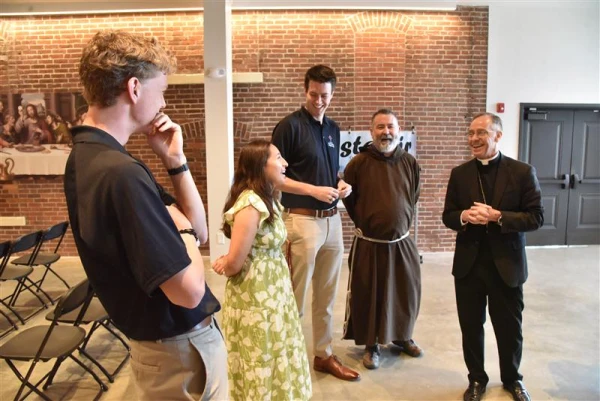
The chaplains were chosen based on a number of criteria. Some reached out directly because they “felt called” and some were were asked if they wished to join based on organizers’ judgment that they would be “a good fit.” From there, pilgrimage staff, the chaplains, and their superiors organized the schedule.
The chaplains are “all stationed in different places” but have traveled to be a part of the experience, Benes said. “In fact, a few are stationed in other countries.”
As they travel, the chaplains take on a number of jobs. “The first part is the pastoral care of the team,” Benes said, adding that some helped lead a February retreat in preparation and a “day of recollection” before the pilgrimage started in Indianapolis.
On the road, the chaplains hear confessions, give homilies, provide reflections, and evangelize. They also help with music during many of the processions, leading worship in both English and Spanish.
“Then the day-to-day of praying with the team, spiritual protection prayers for the team, and any pastoral concerns that come up. Then the second part of their role is to help bring the Eucharist to the public,” Benes said.
CNA spoke to the two Franciscan Capuchins priests — Iwancio and Herlihey — about their experiences so far and their time with the pilgrims.
Father Christopher Iwancio, OFM Cap
Iwancio helped the pilgrims through the retreat prior to their departure. To help calm their nerves he told them that “even the disciples had the same nervousness.”
“They had uncertainty. Even when Jesus ascended to heaven, there was still a little uncertainty for the disciples. There’s something to be ruptured into that encounter experience, but there’s also the practicality, because you have to balance both the spiritual with the practical,” Iwancio told CNA.
Iwancio, who is based in Los Angeles, said the retreat was a time of “getting spiritually prepared,” going over “logistics,” and preparing for “situations that they’ve never seen.”
Logistical matters consisted of “getting the van prepared and reorganizing the trailer.” The pilgrims make four to five stops a day and travel with a van that Iwancio said is “kind of a portable chapel, too.”
(Story continues below)
Subscribe to our daily newsletter
“There’s a tabernacle attached to the van and it serves as a compartment where the Blessed Sacrament can be reserved and that can be opened up and the monstrance fits on top. There’s prayer cards for along the way.” The group organized “the shelves with all the liturgical items.”
“The trailer is almost like a sacristy,” Iwancio said.
Iwancio also helped the pilgrims with the spiritual direction they needed prior to leaving by encouraging them to go to confession and to take time away when they need a break while on the journey. “They need to take care of themselves,” he said.
Iwancio said it is important to balance “being present with Jesus” and the operational matters. “It’s kind of balancing that Martha and Mary approach for the experience,” he said.
“They’re a nice great group of young people and they have a great variety of skill sets because each brings a different gift to the experience … It’s a nice mix of gifts and talents,” Iwancio said.
Iwancio will join the group toward the end of the pilgrimage. “I’m really looking forward to this idea of … bringing hope during the jubilee year. It’s going to be a really awesome experience,” he said.
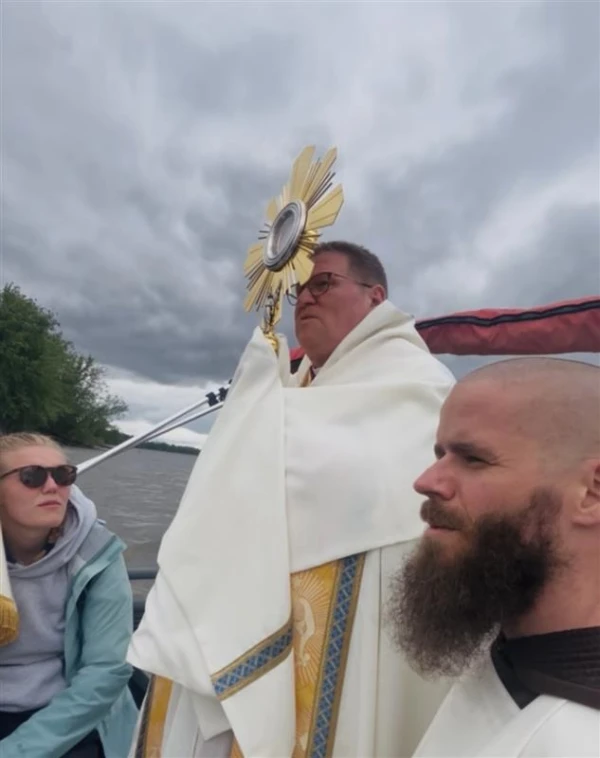
Father Michael Herlihey, OFM Cap
Father Michael Herlihey, the vocation director of Capuchin Franciscans at the Province of St. Augustine, told CNA that “it was important” for him “to spend time with Jesus in the Eucharist as a first-year priest.”
“I was just inspired by … [the] eight young adults. They were willing to step away from their lives, their jobs, their families, friends, cities for a period of five weeks to be Eucharistic evangelizers, if you will,” Herlihey said.
Herlihey also led the initial retreat for the pilgrims and then spent the first 10 days of the pilgrimage with them. He reflected on the week and half of traveling saying that “the intentionality that comes to the pilgrims forming a family … was very powerful. In fact, I think it was one of the strongest parts.”
During his time on the pilgrimage, Herlihey witnessed the Eucharist travel in a boat, a helicopter, and a van. “It’s kind of cool to think of a helicopter being a temporary tabernacle” or a boat “being a temporary vessel carrying Jesus.”
Herlihey shared some of his favorite and most memorable moments.
“I literally got to cross the Mississippi River in a fishing boat with Jesus and see the crowds waiting on the shore for him to arrive. I was pinching myself going, ‘This will be in my homily for decades,’” he joked.
“I understand now, Jesus getting into the boat, going away from the crowds, out into the silence of the water to pray.”
Herlihey also shared some challenges the pilgrims have faced on the journey. They have run into anti-Catholic protestors that started out in small numbers but now travel in groups of around 50 people.
Before the pilgrimage began, Herlihey held a Mass for the pilgrims. He reflected that “in praying over the homily, the Holy Spirit asked … ‘to embrace the cross.’” Herlihey said “to be honest, I didn’t want that to be the homily.” He said he wanted to give an “exciting talk,” but “the Holy Spirit did not budge” — he said he felt the Holy Spirit saying, “You’re going to talk about embracing the cross and the importance of that.”
After the Mass, Herlihey was pleasantly surprised when multiple pilgrims shared that “embracing the cross and embracing death” had been topics they were praying about.
“Now, hindsight is 20-20,” Herlihey said. “Here we are … weeks later, and they’re experiencing crosses. They’re carrying their cross amidst a white martyrdom right now with all the counter-protesters. It’s just like … ‘Holy Spirit, you knew what you were doing.’”
Another difficult part that Herlihey said “pained” him was that they “couldn’t go to more places” with the Eucharist. “I would love to go to every one of the parishioners’ houses, their workplaces, their schools, everywhere. And then I had a thought,” Herlihey said.
“We receive Jesus into our bodies in the Mass, and so we all become tabernacles. And those tabernacles carry Jesus as the helicopter does, as the boat does, as the van does, as the monstrance does. Our bodies.”
Herlihey said the Lord is saying, “I want to give my body and blood to people because I want my body and blood to travel to every office, school, and household. I’m going to do it by making people my tabernacles.”
One thing Herlihey said he hopes people know is that the priests and pilgrims are “not bringing one sacrament,” they are “bringing two.” Herlihey shared he heard confessions for three hours in the procession line as he walked through Iowa.
The chaplains will continue to bring the sacraments to people across Texas, New Mexico, and California as the pilgrimage comes to a conclusion over the next two weeks.




